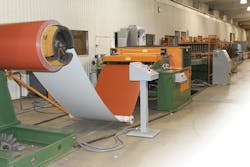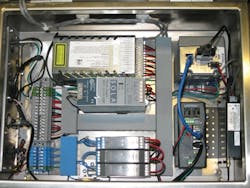The pressure to integrate the plant floor with IT is one of the major reasons why manufacturers are searching for ways to connect to their legacy networks and extract data. But it isn't always easy.
Familiar Refrain
Here's a pretty typical situation from The Bradbury Co. in Moundridge, Kan., which builds complete roll-forming lines, cut-to-length machines, coil-processing production lines, and automated production systems (Figure 1). "Many of our sheet-metal processing lines are still in production after 20 years," says Larry Asher, controls engineering manager at Bradbury. "Over that time, IT and manufacturing departments have been working together and a highly integrated solution is sought by all, but not at the cost of a new production line. Today, our controls department is integrating new technologies and networks with our own legacy systems to meet the needs of our customers."
In 1995, Bradbury released its first computer-integrated manufacturing system. It had a DOS-based PC with a feed program developed in C. The PLC communicated over Data Highway (DH+), the servo systems had their own network, and the I/O used DeviceNet. Soon, customers began to ask for a better way to connect the production line to the office.
Source: The Bradbury Co.
In 1995, Bradbury released its first computer-integrated manufacturing system. It had a DOS-based PC with a feed program developed in C. The PLC communicated over Data Highway (DH+), the servo systems had their own network, and the I/O used DeviceNet.
Soon, customers began to ask for a better way to connect the production line to the office. Dynamic Data Exchange (DDE) was used on a Windows-based PC to exchange data with the DOS-based HMI software. A slew of networks, communication technologies and protocols came from various equipment vendors over the years. Many hours were spent trying to develop methods to collect information, ensure data integrity and make this data available to upper-level systems.
Four years ago, Bradbury began to develop an entirely new control solution based on EtherNet/IP. One goal was to maintain as much of the legacy systems as possible. Replacing functional and supportable components such as drive and I/O would make the solution cost-prohibitive.
Although EtherNet/IP works well on new systems, the problem of integrating older systems remained. Based on when the older unit was built, Bradbury uses different methods for integration.
"Typical legacy systems will have a Rockwell SLC series PLC," says Larry Asher, controls systems engineer for the company. "An SLC 5/03 or 5/04 will be upgraded to an SLC 5/05. We then will install an Ethernet-based network for the HMIs and the SCADA system, and use OPC to exchange data with the production line and the SCADA system. This provides integration to the customer's ERP system. Some older systems might not have a PLC, and in this case we'll use a PLC from the Rockwell Logix family of processors and add any required I/O."
Integrating With IT
"One of our primary IT objectives at McElroy Metal is to provide an integrated information system for our employees," explains Howell Hicks, IT director at McElroy Metal, a customer of Bradbury in Bossier City, La. "We believe integrating our business processes enables us to achieve cost savings, improved efficiencies and a competitive advantage."
McElroy Metal makes metal roofing and siding products. The company's operations include 12 manufacturing facilities, 18 service center locations and 40 Metal Mart locations. Connecting it all together was a challenge, especially when dealing with legacy networks.
"Integrating IT infrastructures with shop-floor technology is a challenge, since the methods, networks, operating systems and processing components were developed through different channels for users and equipment with different needs," Hicks explains. "The resources and skill sets employed to keep an ERP system, email system and office productivity software operable and available on a network powered by Microsoft are quite different than those required to make controllers talk to PLCs."
McElroy Metal wanted to port information entered into its ERP order entry system to its mill controllers, and thereby improve the overall efficiency of the process. "The effort to integrate our business software and data with our shop-floor software and data has been rewarding, but with great effort and considerable cost," Hicks says.
Bradbury supplies most of the manufacturing equipment used by McElroy, and the two companies worked on this effort together. "We've been able to jointly develop interfaces that couple our IT infrastructure to our shop-floor controllers," Hicks adds.
"The companies created joint testing labs at Bradbury's facility in Moundridge, and at McElroy's facility in Bossier City," Asher says. "Those efforts allowed us to replace obsolete components such as DDE communications servers with OPC. Most of the solutions we evaluated simply required moving to an Ethernet-capable PLC. Over the last year and a half we've retrofitted three production lines for McElroy Metal."
Back to the 1990s—and Beyond
Greg Lesniak is corporate electrical engineer for Tree Top, an agricultural cooperative representing apple and pear growers in the Northwestern U.S. It produces fruit juices and other products in seven production plants in Washington and Oregon, and also was dealing with networks from the 1990s. Lesniak was trying to gather process data from all its facilities, but ran into problems with legacy networks.
"Most of the processing lines are running automation systems put in place in the early to mid-90s, and many of those systems use legacy serial networks such as Profibus," Lesniak says. "Further complications include standalone OEM systems that don't talk to the main controllers without a large amount of effort, and the need to utilize the investment in legacy device networks for some period into the future."
Lesniak went wireless by installing a newly developed PlantMesh wireless mesh Ethernet system from WingTip to gather the data. He connected the main network controller to a Ciscdo switch in the network room for the plant. Then he installed MeshNodes in machine control panels and sensor panels (Figure 2).
"The MeshNode is connected to an A-B CompactLogix PLC through a Profibus interface via a ProSoft chassis card," Lesniak explains. "The PLC has arrays defined by user-defined data types that the historian OPC server connects to and transfers data from. The PLC has three Profibus cards, one master and two slaves. The master is controlling I/O and VFDs directly, and the slaves are transferring data from other Profibus networks. We have other A-B PLCs that have Ethernet ports or the NET NEI interface that A-B manufactures, which turns an A-B SLC or MicroLogix PLC serial port into an Ethernet-enabled port."
With his plants having so many tanks, conveyers, piping and other metal obstructions, reflections and interference have the potential to make a wireless system difficult to use, Lesniak says. "But PlantMesh changes routes from our controllers when we have communications issues or node problems, and the system works well."
Even Older
While Bradbury, McElroy and Tree Top deal with legacy networks that are 20 years old, one oil and gas drilling industry network goes back even further than that. The Wellsite Information Transfer Specification (WITS) is used to transfer well-site data from one computer system to another over a serial network. Lee Hilpert, president of GTech-HilTech in Conroe, Texas, often works with WITS, and he's not sure how old it is.
"In the 1980s, maybe even earlier, the drilling industry realized the need for a communications standard, as instrumented and networked devices became deployed on drilling rigs," he explains. "WITS was developed so various pieces of drilling equipment could talk to each other, and every company in the oil and gas drilling industry still conforms to it." That means many new devices still have to connect to a network from the 1980s. See the sidebar, "Keeping Your WITS About You," to see just how difficult this was.
Friesen's, based in Detroit Lakes, Minn., manufactures material handling, check weigher and fluid power systems for the food manufacturing and packaging industries, and connects its modern systems to some older legacy networks.
Kari McAllister, director of product development at Friesen's, says they have standardized on EtherCat for simple connection to essentially any Ethernet TCP/IP, serial RS-232 and CANopen device. "We can connect easily to a wide range of machines and devices while eliminating the legacy cards used in PCs, reducing cost and hardware size in the process."
McAllister recently upgraded Friesen's check weigher. "We wanted to process product weights faster and communicate to our reject systems at higher speeds, and at the same time provide connectivity to older protocols."
Nathan Eisel, application support engineer at Beckhoff Automation, explains how his company's hardware and software enables communication to various networks. "TwinCat software downloads configuration data to each EtherCat master/slave terminal, while the EtherCat network phases to operation (OP) mode," he says. "Once in OP mode, data is simply cross-mapped from the legacy network to the EtherCat side of the terminal, and the data is transmitted back to the EtherCat master. All of this data can be passed over one standard Ethernet or fiberoptic cable, and we use XML description files to define how the master communicates with the slave.
Keeping Your WITS About You
GTech-HilTech, located in Conroe, Texas, builds equipment for the oil and gas industry, including decanter centrifuges, pumps and control panels. Key employees have 30 years' experience in the industry, so one would think the Wellsite Information Transfer Specification (WITS) would be easy for them to integrate.
To appreciate this standard, you need to understand the mentality of the drilling industry, says Lee Hilpert, president. "When a drilling rig is built, it's outfitted with the basic equipment required to drill a well," he explains. "Other equipment is provided by service companies who deploy their specialized services on an as-needed basis." So equipment comes and goes on a rig, and it all has to talk to each other. To make this happen, many drilling systems conform to the WITS standard, which is an old and slow serial network.
This custom panel was built to translate an existing legacy network to a modern communications protocol.
Source: GTech-HilTech
GTech-HilTech built a control panel for a local company, and had to provide a WITS interface for it (Figure 3). "We were amazed to find that you cannot just buy an off-the-shelf device that converts data from our PLC to a protocol that's acceptable to WITS," Hilpert laments. "In fact, while it's a very defined protocol, the implementation varies from job to job."
They had to develop logic in a National Instruments cRIO controller to act as a gateway to the WITS protocol—and then write code to analyze the WITS structure, identify an open channel, and set up the gateway to propagate the information over the open channel in the proper WITS format.
"This panel was a communications nightmare just because the oil and gas industry is so slow to change," Hilpert says. "Developing the logic to communicate took more resources than writing the code to make the equipment work."
In the end, GTech-HilTech successfully implemented communications with the legacy WITS network, and it now has in place a standard hardware platform to integrate this unique network into the world of modern communications systems.
Keeping the Old System
Replacing existing equipment is expensive, notes Joe Sebastian, systems engineer and general manager at systems integrator Optimation in Rush, N.Y. "The main reason I see for keeping older networks is to maintain a large installed base of equipment that all uses a particular network," he says. "To replace all the equipment at once would require a great deal of downtime and a large capital investment."
Sebastian cites an example of an existing Modbus Plus network that was maintained by integrating to a new Siemens Profibus network. "The manufacturer was standardizing on Siemens worldwide, but didn't want to expend the capital required to replace existing automation components," he explains. "The solution was to use most of the existing components. Where necessary, protocol converters were put in place and configured. This allowed the manufacturer to gain functionality immediately and upgrade remaining components later, on a schedule that its budget can handle."
Over many years, the older automation components will be phased out completely. "Phasing out the old and gradually replacing it with newer technology will add to the lifespan of the equipment," he says. "In addition, the upgrades add features that come with new technology."
There Are Always the Vendors
One pretty basic way to connect to a legacy network is to go back to the vendor, says Richard McCormick, automation engineer at system integrator Mick Automation in Levis, Quebec. "Honeywell networks are covered by 'proprietary integration,'" he says, meaning it's embedded in their systems. "TDC 2000 Data Hiway to TDC 3000 LCN legacy systems are integrated through standard interfaces provided by Honeywell."
The same could be true for your distributed control system (DCS) or PLC. If you have a legacy network, there's a good chance that the vendor provides an upgrade path. Alternately, a third-party vendor can be used to integrate a legacy network.
Cindy Hollenbeck, vice president at SoftPLC, has a customer that wanted to keep its legacy DCS running, but migrate it to modern communications. "The legacy DCS system had Allen-Bradley Data Highway Plus (DH+) communications," she explains. "The migration desired was to Ethernet and a new I/O structure based on Profibus. The DCS communication options were limited. They used our SoftPLC product as a controller and a gateway between DH+ and the I/O."
Pepperl+Fuchs supports many industrial networking solutions, says Helge Hornis, manager of the Intelligent Systems Group. "This is necessary because only certain technologies are supported by the various PLC manufacturers. As of today, we provide products to integrate DeviceNet, EtherNet/IP, Profibus, Profinet, Modbus TCP, and CC-Link. We also continue to support Allen-Bradley Remote I/O for those customers that have legacy installations. In terms of development resources, we're putting a big emphasis on Ethernet-based solutions."








